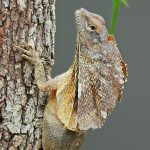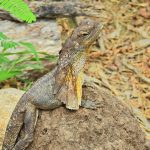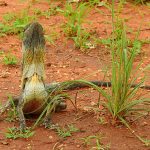FRILLED-NECK LIZARD
The Frilled-neck lizard, a creature that looks like it stepped straight out of a prehistoric painting!
This fascinating reptile is most famous for its spectacular frill—a large, colourful membrane of skin that encircles its head. When threatened, it dramatically unfurls this frill, much like an Elizabethan collar, to appear larger and more intimidating. The frill is not just for show! It also helps regulate body temperature by increasing the surface area exposed to the sun.
These lizards can run on two legs, much like a miniature dinosaur, which is quite the spectacle!
Typically, Frilled-neck lizards are grey, brown, or black, with the frill often displaying vibrant hues of orange, red, or yellow.
While not particularly vocal, frilled-neck lizards may hiss or make a low growling noise when threatened, often accompanying their frill display.
They can live up to 10 years, though this can vary based on environmental conditions and predation.
Native to northern Australia and southern New Guinea, it thrives in tropical and warm temperate forests and savannah woodlands, where it spends much of its time in trees, descending primarily to feed or to move between trees.
Breeding occurs in the wet season, from September to March. After mating, the female lays between 8 to 23 eggs in a burrow, which she covers with soil. The eggs incubate for about 70 days, and the hatchlings are independent from birth, receiving no parental care.
These lizards are primarily insectivorous, feasting on ants, termites, and small vertebrates. They are ambush predators, relying on stealth and speed to capture their prey.
In Indigenous Australian cultures, the frilled-neck lizard holds significance in various Dreamtime stories and is often seen as a symbol of adaptability and survival. It features in art and oral traditions, highlighting its importance in the cultural landscape.
















